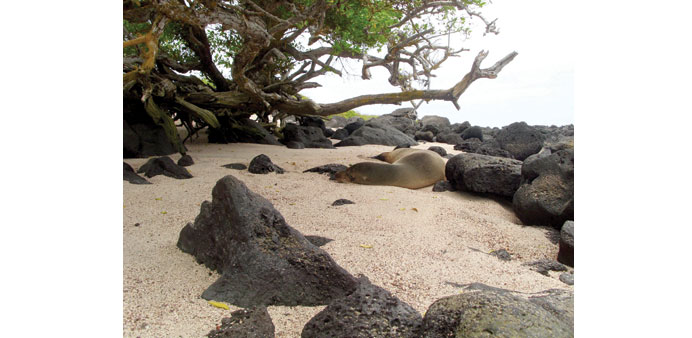By Ramiro Carrillo
Since 2009 about a dozen new species of fish, animals and corals, among them a spectacular pink iguana, have been discovered on or around the Galapagos Islands.
The Pacific Ocean archipelago, where Charles Darwin’s theory of evolution was hatched, is proving to be an endless source of work for biologists and scientists delighted by the discoveries.
Co-ordinated by the Galapagos National Park, dozens of researchers and biologists from institutions from different countries work tirelessly to observe the ecosystems on the islands, which are a province of the South American country of Ecuador.
What might be the world’s most pristine habitat shelters fragile life forms that might never have established a footing elsewhere.
In July, biologists from the University of San Nicolas de Hidalgo in Mexico and the Ecuadorean Environment Ministry confirmed the existence of two new fish species, the Scorpaenodes sp. And Gobiomuros sp., which measure between 10 and 25 centimetres.
They swim in the rocky waters and reefs surrounding the islands of San Cristobal (Chatham), Santa Cruz (Indefatigable), Santa Fe (Barrington), Espanola (Hood) and Isabela (Albemarle).
“The discovery of these two new marine species confirms that the Galapagos are a living laboratory and that we still do not know all the species that co-exist in it,” said the director of the Galapagos
National Park, Arturo Izurieta in remarks to dpa.
“This contributes to the knowledge of marine fauna, science and research of the Galapagos’ unique ecosystems.”
The two fish species join the 2,900 species that have already been identified on this island marine reserve, 25 per cent of which are native to the region.
In early 2009 scientists made a surprising discovery on the Wolf Volcano on Albemarle Island.
Researchers from the University of Rome Tor Vergata found a pink iguana with features that were different from the black sea iguanas and the land iguanas whose backs and crests are of a yellow colour.
The discovery of the pink iguana, described as a “living fossil,” is fascinating to scientists.
“It is surprising to have made a discovery of this nature in the 21st century,” said Ecuadorean biologist Washington Tapia.
In 2012 scientists catalogued a new shark catfish species: Bythaelurus giddingsi, which lives at a depth of between 400 and 600 metres in the ocean surrounding the Galapagos Islands. It can measure 30 centimetres and has light-coloured spots on brown skin.
The Galapagos sea has recently spawned a new coral species. Researchers from the US and British universities of Miami and Southampton identified three coral organisms in the reefs and rocky volcanic shorelines of Darwin and Wolf islands.
One of these species, earlier thought to have been extinct, was able to survive the fierce weather of the El Nino weather phenomenon. This finding made scientists realize that “some coral species are more resistant than we thought,” said chief researcher Terry Dawson.
The Charles Darwin Foundation, working on the Galapagos since 1959, in 2010 offered the results of work with lichens and announced the discovery of 10 new species.
In 2013, local fishermen delivered to authorities a rare fish belonging to the Uranoscopidae family with a round mouth and elongated body, with characteristics different to others found elsewhere in the world.
After focussing their work on the small island of Daphne, British scientists Peter and Rosemary Grant, from Princeton University, published in the US National Academy of Sciences results of research they had conducted for 28 years on a new class of finch.
The object of their study had a bird song and beak that differentiated it from other finches on the islands and was registered as a new species in 2009.
Finches varying in size and beak function from one island to the other were key for Darwin to write his landmark book on natural selection, The Origin of Species.
Currently, computer technology and robots for land research as well as submarine robots make scientists’ work easier.
“These contributions will help us identify priority sites for preservation and interest we must focus on,” said Izurieta.
Potential subjects for research programmes appear limitless. For example, scientists recently launched a project to investigate hydrothermal vents, formed when seawater meets hot magna, located on the oceanic spreading ridge near the Galapagos Islands.
This habitat, which is low in oxygen, lacking sunlight and with gases and fluids at temperatures of up to 400 degrees Celsius, is, for animals living in its vicinity, unlike any other in the world.
As it contributes new species to the world, the Galapagos Islands face the risk that flora and fauna found on them could die out.
Man’s predatory activity has already led to the spread of species such as goats, rats and weeds that are difficult to control.
In 2012 the world watched the death of Lonesome George — the last living specimen of a type of giant tortoise unable to reproduce to keep it from going extinct on the island of Pinta.
Fortunately, scientists recently located specimens that are very close genetically to Lonesome George.
The Galapagos Islands, declared a World National Heritage Site by UNESCO, thus provide daily lessons on the importance of protecting nature and wildlife. -DPA

